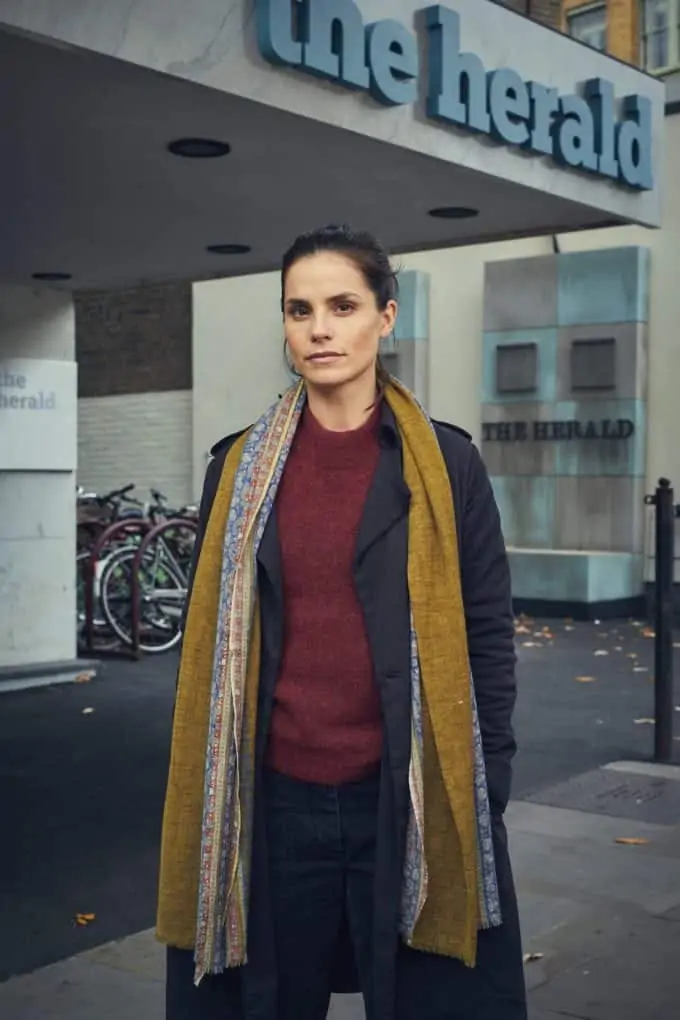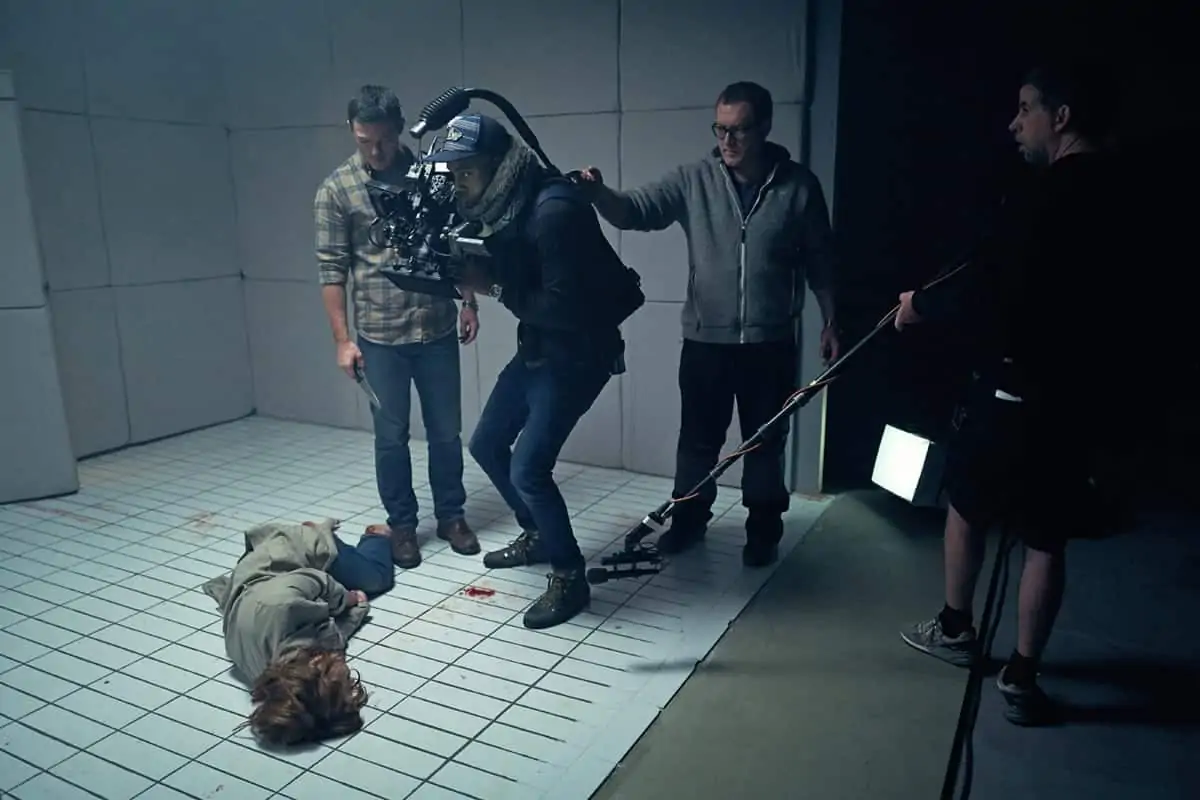Broadsheet Battles
Kate Reid / Press

Broadsheet Battles
Kate Reid / Press
BY: Valentina Valentini
Lead image by David Suchet
In the fictional land of Press – the BBC’s newest situation drama premiering on TV in September – there exist two main worlds: The Post and The Herald. They are competing newspapers at the centre of London’s fast-spinning daily news coverage and the sets were designed, by Paul Cross, with very specific aesthetics in mind and shot by cinematographer Kate Reid with the same aim.
The Post is all blacks, grey and bright splashes of red and keeping with a sharper, newer image, whilst The Herald has teals, light blues and beiges, harkening a more family oriented atmosphere.
“We wanted it to be very clear which office we were in so that cuts between the two could easily be followed by our audience,” says Reid, who has worked on many TV shows like Call The Midwife, Marcella and the upcoming series Hanna, based on the 2011 film. “But we also didn’t want it to create a bias towards one paper, or lead the audience to have sympathy with one over the other.”
With television shoots in the UK, there is usually a different director and DP in two-episode blocks, but the producers of Press wanted the same team – Reid and director Tom Vaughn – for the whole season. Shooting on two ARRI Alexa Minis, Reid worked on six episodes concurrently over an 80-day shoot.

“It was a challenge,” says Reid, “knowing the story well-enough that you can keep an eye on the progression of the characters and the movement of their storylines with the tone of lighting across the locations.”
Reid had done a couple of indie features and dozens of shorts over the last decade and is happy with the transition into television: “That is where the opportunities currently are,” she says. “And that is where the budget is. If the script is good and you’ve got a great director you can tell a story well, which is exciting regardless of the format.”
For Press, The Herald set was built on the largest stage at 3 Mills Studios in London and The Post was a practical location in North London that was adapted to the production’s needs. The Post location was 230-feet long, which gave Reid and her team plenty of Steadicam walk-and-talk room in order to get the sense of scale: “The Post and the lead character, Duncan Allen [played by Ben Chaplin] is very hierarchical, where he’s the leader and everyone else is beneath him,” offers Reid.


Because one was a studio and one was a location, each had very different lighting set ups, but across the whole show, Reid aimed to maintain a ‘commercial and inviting’ look to both.
“It was important to welcome the audience into this warm and relatively bright colour palette and let them know that it wasn’t going to be a heavy drama – though there are dramatic moments,” she says. “The Post is the more entertaining space to be in, in terms of dialogue, so I wanted to keep it bright. We were shooting during December in that space with very short days and it was a real challenge to keep the lighting consistent, given all the windows.”
To combat those short daylight hours, Reid and her lighting team, gaffer Charley Cox and best boy Mark Keane, put seven 18K HMIs on machines outside the windows that ran the length of The Post building. Depending on the time of day she was creating, she would add colour correction gels (degrees of CTS or CTB) or diffuse the heads. Other times, for speed, she used frames that they’d built to fit the windows on location that could be put on the inside, with either a Hampshire frost or 1/4 diffusion gel on them, to variously manage the exterior ambient, cheat the time of day when they’d lost the light, or to help with matching to exteriors they’d already shot on location.
"I really enjoy shooting faces on wider lenses close to the character, giving a slightly exaggerated feel. This show spends a lot of time on characters’ faces, so having them play so strongly, front and centre in the frame worked."
- Kate Reid
On the opposite side, Reid was limited because of another building that was quite close. So she frosted the windows with a heavy frost and set in Skypanels in order to create a gentle ambience. The Skypanels were all programmed to a DMX board in order to change their colours and levels easily.
When it came to lighting The Herald offices, at the set built at Three Mills Studios, Reid and her lighting team wanted to create a softer, warmer more domestic feel to the space. Being in a studio and moving to Tungsten sources naturally helped create a shift in the feel of the light of this space. The set was rigged with 240 Kino Flo 4ft 4Banks in the ceiling, with a further 60 rigged outside the set windows to light the Rosci SoftDrop translights, which ran along two sides of the set, and provide the effect of the exterior ambient light. Harder Tungsten heads (5Ks) were rigged for more directional light along the windows as required. This allowed for a flexible base lighting set-up that could quickly and easily be adjusted to reflect the required times of day (the team shot in story order in this location) and Reid credits her lighting team, Cox and Keane, for making this work so well.


Though Reid loves vintage glass, often leaning toward older lenses like the Canon K35s or the Cooke S2s, she chose Panavision Primos for Press. She used different diffusion depending on the scene in The Herald, but didn’t want to shoot with diffusion in The Post as she aimed for a cleaner feel there. In fact, anything that was part of Duncan Allen’s world – like his apartment in the city – was kept a bit sharper.
“I used the Primos on the show Trust Me and really liked how they fell off when they were wide-open,” says Reid, “but on this show I didn’t want to use them wide-open. We tended to shoot T2.5 to T2.8. Although the primary character in the show is Holly Evans, there are a lot of key characters. When we were with Holly, we did shoot closer to her and have a shallower depth-of-field, shooting wide-open to isolate her from her environment and draw the audience into her world, allowing the image to fall apart a little as the Primos do beautifully when wide-open in the more emotional moments with her character.”
“I really enjoy shooting faces on wider lenses close to the character, giving a slightly exaggerated feel,” says Reid. “This show spends a lot of time on characters’ faces, so having them play so strongly, front and centre in the frame worked.

“The character of Duncan Allan is big. The world he occupies in The Post revolves around him, he drives the scenes and the space with his energy and repartee, so I tended to shoot his close ups on a 27mm when we were in that larger-than-life world. Outside of this space, in his private life, it wouldn't be as extreme and I'd move to a 35mm. Ben Chaplin, who plays Duncan, has such a strong and expressive face than can really handle this style of shooting.”
“In The Herald, which is more grounded in reality and less exaggerated than its rival paper, I would usually use a 35mm or 40mm for close-ups with Holly, Amina and the other characters, which both suited this world and was more flattering on their faces. The exception to this were extreme moments of emotion with Holly, where I might go wide and allow the camera to be more intimate in its proximity.”




